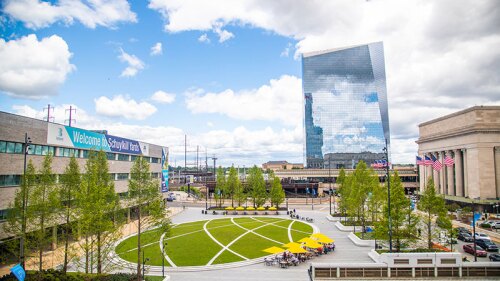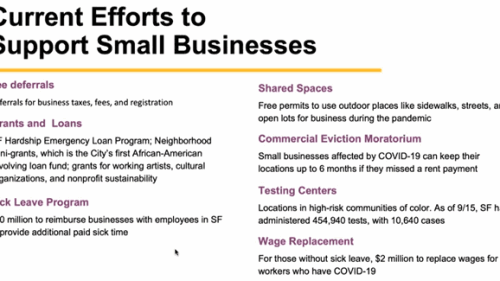In many cities around the world, the bulk of office employees are working from home, retail shops are closed or operating at reduced capacity, and hotels are largely quiet. In the face of unprecedented economic realities, commercial real estate owners are facing the potential for reduced capacity for an undetermined amount of time.
Given this uncertainty while buildings are temporarily empty or drastically reduced in usage, owners can optimize buildings’ operations to help their bottom line.
While operators cannot simply “turn off” an entire commercial property, there are ways to leverage efficiency to reduce the utility cost burden during these times.
Generally, an office building’s largest energy-using systems are HVAC (40 percent), lighting (20 percent), and plug loads (33 percent), which can all be addressed via low-cost, high-return-on-investment improvements. Now is an excellent time to identify operational efficiencies to lower energy use in the building, address deferred maintenance, and reduce operating expenses.
Facilities and engineering staff are often categorized as “essential” workers and are still going into the buildings daily. With few (if any) occupants, and thus fewer maintenance requests to address, staff may have the capacity to finally implement operational improvements and deferred maintenance projects on building systems—and can do so during the day without interrupting office workers.
Commercial facilities can enact a few simple measures to immediately drive down energy use and reduce costs. If no one is in the building most of the day, these simple steps can make a significant impact:
- HVAC: Operate the building automation system on a weekend or holiday schedule with reduced hours, delayed startup, lower setpoints, and wider temperature dead-bands (while maintaining appropriate ventilation and air quality);
- Lighting: Turn off the lights in tenant spaces and common areas; and
- Plug load: Turn off and unplug appliances like televisions, monitors, printers, and kitchen equipment.
“We’ve implemented measures such as cycling air handler units only a few hours a day, adjusting set points, and walking vacant floors to confirm that only emergency lights are on, and [we] are actively working with our peers to share best practices to go further,” says Jonathan Bauer, sustainability manager with the Tower Companies.
For buildings with some tenants still occupying space, it is important to engage and communicate with them to optimize building operations:
- Learn their revised occupancy strategy and schedules to right-size building services (by zone or by floor) to match this new level of activity;
- Discuss reduction in use of dedicated tenant HVAC units as appropriate; and
- Encourage tenants to turn off lights and unplug equipment when not using the space.
As building teams implement energy efficiency activities, it is important to consider the following nuances:
- Leases: Make sure that operators are allowed to implement these energy reduction activities, and get tenant approval in advance if necessary.
- Energy contracts: Some buildings have long-term contract agreements with utilities to pay for a minimum amount of energy even if they are not using it; while it still makes sense to take action on energy efficiency now, the minimum energy requirement in a long-term energy contract may hurt the return on investment (ROI) of an energy-saving investment.
- Essential workers: Assuming that cleaning and security staff are still entering the building, ensure that the space is safe for them to work (even if it hinders energy performance).
- Do not shut everything off: Be sure to run minimal HVAC and ventilation to keep mold out, and to ensure that all mechanical systems are in working order in preparation for tenants’ return.
To assist, resources exist like the U.S. Energy Star Program’s “Treasure Hunts” to guide staff on identifying quick ways to save energy, with firms like Hudson Pacific Properties rolling them out across segments of the portfolio during this office downtime. The Tower Companies’ engineering and sustainability teams have been laser-focused on energy efficiency during this time of low occupancy, reducing energy consumption by 10 to 50 percent in some buildings.
ULI’s Unlocking Hidden Value in Class B/C Office Buildings report is another useful resource that identifies proven, simple, low- to no-cost measures to improve energy performance. Energy management system (EMS) vendors are also stepping up their analytics platforms to reflect these new energy load profiles; DWS Group is working with its EMS provider to assess consumption patterns across portfolios with a pre-COVID-19 baseline to proactively identify specific assets and opportunities for energy savings.
“We have deployed smart meters and enhanced energy analytics in a number of our large buildings, and we can use these tools to track our usage in real time and monitor the outcomes of our energy reduction programs. Through strategies like this, we can reduce operating expenses for our properties and tenants during this challenging time,” says Jessica Elengical, head of ESG strategy, alternatives, at DWS Group.
Last of all, if a property does not yet track and benchmark its energy use over time, now is a good time to start. Facility teams can collect one to two years of monthly utility bills and energy consumption data to understand the property’s baseline level of usage, and then measure the savings from implementing these operational efficiencies. The U.S. Environmental Protection Agency’s Energy Star Portfolio Manager is a free online tool to facilitate this analysis.
Focusing on energy- and cost-saving opportunities helps minimize operating expenses in these uncertain times. The business case is clear: reduce energy use, increase building value. Low- and no-cost upgrades are much easier to identify and execute when building staff are in the building and tenants are not. There is no time like the present to get going on energy efficiency.





